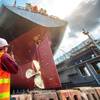Trash Talk
Are You Prepared for the New MARPOL Annex V Garbage Regulations?
New regulations addressing garbage management go into effect on January 1, 2013 pursuant to action taken by the Marine Environment Protection Committee (MEPC) at its sixty-second session in July 2011 after a comprehensive review of MARPOL Annex V. The new regulations impose stricter garbage management procedures and documentation requirements for all vessels and fixed and floating platforms which will have major implications for industry, as discussed below. The revised MARPOL Annex V, contained in MEPC.201(62), is available on the IMO’s website for the Marine Environment Protection Committee (MEPC), 55th session at http://www.imo.org/OurWork/Environment/PollutionPrevention/Garbage/Documents/201%2862%29.pdf.
The most significant change in the new regulations is its general approach to garbage management. Under the current regulations, discharge of garbage into the sea was generally allowed unless specifically prohibited or limited. This concept is reversed in the new regulations, which impose a general prohibition on the discharge of all garbage unless the discharge is expressly provided for under the regulations. To aid in identifying the categories of garbage which may be discharged, the new regulations include a host of new definitions, such as for “animal carcasses,” “cargo residues,” “cooking oil,” “domestic wastes,” “fishing gear,” “food wastes,” “incinerator ashes,” and “operational wastes.” The new regulations allow the limited discharge of only four of these categories: food waste, cargo residues and certain operational wastes not harmful to the marine environment, and carcasses of animals carried as cargo. Combined with the general prohibition on the discharge of garbage outside these limited categories, the new regulations greatly reduce the amount of garbage that vessels will be able to dispose of at sea. Below is a simplified overview of the new discharge provisions that is posted on the IMO website.
Any garbage permitted to be disposed of at sea must be discharged while the vessel is “en route.” Per the definitions, “en route” means that “the ship is underway at sea on a course or courses, including deviation from the shortest direct route, which as far as practicable for navigational purposes, will cause any discharge to be spread over as great an area of the sea as is reasonable and practicable.”
Stricter regulations will pose a number of operational challenges. The increase in the quantity of garbage required to be retained onboard and disposed of ashore is likely to create a host of logistical problems for vessels and port authorities with regard to storage, equipment, and sanitation. Indeed, many existing ships will not be able to handle the amount of garbage requiring incineration and many port authorities will not be able to handle the large amounts of dunnage without substantial investment and planning. Vessels will incur higher port garbage service charges which will have to be taken into account in chartering agreements. In addition, greater limitations on the discharge of cargo residue and wash water will affect if, how, and where the cleaning of holds and external surfaces may be conducted. For example, any cleaning agents used to wash exterior surfaces may be discharged only outside special areas and the vessel must have evidence from the producer of the product that it meets certain criteria for not being harmful to the marine environment.
The new regulations also expand documentation requirements for vessels and offshore platforms. Garbage management plans must be revised to reflect the new regulations. The IMO published guidelines for the drafting of new garbage management plans, MEPC.220(63), available at http://www.imo.org/OurWork/Environment/PollutionPrevention/Garbage/Documents/220%2863%29.pdf, which outlines items that should be covered by the plans. The requirement to have a garbage management plan is expanded to include all vessels of 100 gross tons or greater, whereas under the current regulations garbage management plans are required for vessels 400 gross tons or greater. Fixed and floating platforms must also have a garbage management plan under the new regulations. In addition, the Garbage Record Book on all vessels must be replaced. The new version of the Garbage Record Book includes revised categories and requires entries to be itemized by category, if possible. Fixed and floating platforms must also maintain a Garbage Record Book under the new regulations. Finally, the requirement to post placards is extended to offshore platforms. Placards currently in place on all vessels must be replaced as well.
The IMO published “2012 Guidelines for the Implementation of MARPOL Annex V” to aid governments, ports and terminal operators, ship owners and operators, vessels’ crews, and equipment manufacturers in complying with the new regulations. The guidelines outline a number of recommended waste minimization and handling techniques, including that vessels minimize taking on material that could become garbage. A number of tactics are suggested in the guidelines, such as ordering supplies that come in bulk packaging as much as possible, avoiding the use of disposable dinnerware and towels, and utilizing reusable cargo coverings, dunnage, and packing materials. The guidelines also suggest multiple garbage sorting practices, emphasizing the need for careful planning of garbage handling under the new regulations as more garbage will need to be stored onboard until it can be properly disposed of ashore. An analysis as to the advantages, disadvantages, and effectiveness of grinders, compactors, incinerators, and other garbage handling equipment is provided to aid in garbage management decisions. As the new regulations will increase the quantities of garbage offloaded to shore based reception facilities, the guidelines further provide suggestions for garbage management decisions for port reception facilities and encourages consideration of alternative reception facility methods, such as the use of barges or self-propelled vessels as floating plants for garbage collection. Revised sample placards targeting crew, offshore platforms, and passengers are located at the end of the guidelines. The guidelines, MEPC.219(63), are available at http://www.imo.org/OurWork/Environment/PollutionPrevention/Garbage/Documents/219%2863%29.pdf.
Vessels operating in the United States have experienced increasingly heightened enforcement of, and penalties under, oil pollution prevention requirements under MARPOL Annex I and, more recently, air pollution prevention requirements under MARPOL Annex VI. It is unclear, however, at this time when the Coast Guard will publish enforcement guidance on what to expect when the revised MARPOL Annex V goes into effect shortly. In conclusion, owners and operators of vessels, offshore platforms, and port authorities have precious little time remaining to prepare for these new requirements not only from a logistics and equipment standpoint but also from a training standpoint.
The clock is ticking—are you ready?
Jonathan K. Waldron, partner at Blank Rome, concentrates his practice in maritime, international, and environmental law, including maritime security.
[email protected]
Dana Merkel, associate at Blank Rome, focuses her practice on providing legal advice to companies involved in the maritime industry.
[email protected]
(As published in the November 2012 edition of Maritime Reporter - www.marinelink.com)


















